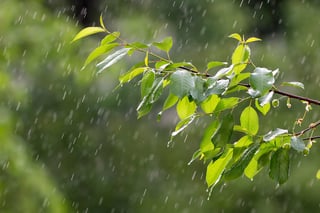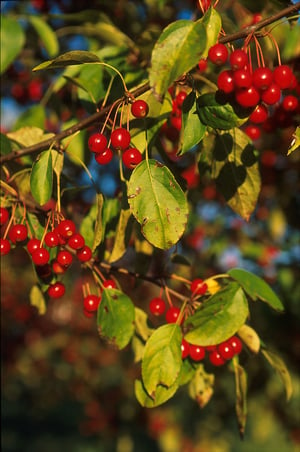It’s the gift that keeps on giving: this year’s record breaking wet spring (nearly 170% above normal) is likely to linger on into the summer when it comes to its effects on the landscape. Why? Because wet spring weather creates perfect conditions for root rot and other problems. Left untreated, these can begin to damage or even kill plants when the weather turns hot and dry, leaving your commercial property looking less than attractive throughout the summer and fall.
How Will This Year’s Wet Spring Impact Your Property?
 A wet spring calls for special vigilance when inspecting the landscape and proactively responding to signs of potential damage. Some common problems caused by wet spring weather include:
A wet spring calls for special vigilance when inspecting the landscape and proactively responding to signs of potential damage. Some common problems caused by wet spring weather include:
- Water issues, including flooded basements, damaged or clogged gutters, and/or erosion
- Compaction due to foot or mower traffic over saturated soil
- Low oxygen content and proliferation of pathogens in the soil—another consequence of saturated soil
- Root rot
- Fungal disease on leaves and other plant tissues
Knowing how to identify these issues in their early stages can help grounds managers minimize damage to the landscape by taking immediate action to remedy the problem.
What Are The Early Symptoms Of Disease Due To Overly Wet Conditions?
Early symptoms of plant illness due to overwatering and saturated soil can be difficult to identify. Often the same pathogen will manifest different symptoms in different species of plants. The important thing is to recognize if the plant is displaying abnormal or unhealthy growth.
Klausing Group’s horticultural specialists are prepared to identify those issues during regular inspections of our clients’ properties. We can identify problematic areas in the soil, and are aware of which plants are most likely to experience problems, so we can start treating the issues right away.
Close inspection and immediate action are important, because symptoms can be subtle and often don’t become readily apparent until June or July—which is often too late. Once the hot, dry spells of summer hit, plants suffering from root rot or sitting in compacted soil will wilt sooner than other plants leading to dead tips on branches, because their stressed roots can’t take up water properly. Dead tips on branches is a big sign your plants are in trouble; but early treatment can oftentimes save the plant. But not all diseases have cures and infected plants will need to be replaced with more appropriate and resistant plants to keep the property looking as it should.
How We Treat And/Or Replace Damaged Plants
 Some problems occur every spring regardless of how wet it is. One common example of a perennial problem is apple scab on Crabapple trees. This disease can cause damage on leaves and lead to early defoliation in the summer. Luckily, it is easily treated with a preventative application. Other problems become more exaggerated as precipitation increases, like needle diseases on spruce trees and root rots on shrubs and trees. Even annuals can rot from fungal diseases.
Some problems occur every spring regardless of how wet it is. One common example of a perennial problem is apple scab on Crabapple trees. This disease can cause damage on leaves and lead to early defoliation in the summer. Luckily, it is easily treated with a preventative application. Other problems become more exaggerated as precipitation increases, like needle diseases on spruce trees and root rots on shrubs and trees. Even annuals can rot from fungal diseases.
However, not all of these problems can be solved with chemicals. Some fungal plant diseases have no chemical cure, and it becomes necessary to replace the plants. In these cases, we want to be sure to select appropriate replacements. Prevention is the best solution: it’s not uncommon in our area to see certain plants included in a landscape which may look good for a season or two, but don’t do well in Kentucky over the long term. Many of these are susceptible to root rot, and are best replaced with more appropriate plants to our area. Putting the right plant in the right place will help to maximize plant health as much as possible.
Sometimes, too, a remedy is not as simple as removing a dead plant and putting in a different one. In low areas or spots where root rot and/or compaction is a consistent problem, drainage work and/or other approaches may be required. One property we took on had terrible problems with compaction and bad drainage. A poorly designed irrigation system combined with a wet spring had compounded the problem, resulting in extensive damage to the landscape. We applied a combination of solutions to solve the issue. We changed out the irrigation, and removed plants that weren’t doing well, replacing them with plants more tolerant to saturated soil. In addition, we inundated the soil with beneficial microbes and fungi several times per year, displacing the pathogenic soil organisms with good ones for long term improvement in soil and plant health. The project won an award through the National Association of Landscape Professionals.
If Not This Spring, Then Next...
The spring of 2018 has been one for the record books, and it is tempting to think it won’t happen again soon. However, it’s important to note that Kentucky’s climate has been getting wetter over the past few decades. In fact, the Kentucky Climate Center has data showing the Bluegrass is 3.8% wetter now than only 40 years ago. Wet springs are likely to be a perennial problem in our area, as climate experts are predicting a continuation of this trend over the next 40 years.
.png?width=600&name=image001%20(1).png)
As landscape professionals, climate changes such as this are not just a matter of numbers and charts. We come face to face with the results every day. We have been seeing an increase in certain diseases as a result of the increased rain in our region. While it’s not a cause for alarm, it is a cause to be better educated about conditions, and it is important to be proactive about managing the landscape to avoid excessive problems under these conditions.
If you would like to know more about addressing problems in your landscape caused by this spring’s wet weather, or how we can help you avoid such issues in the future, contact us here today.


